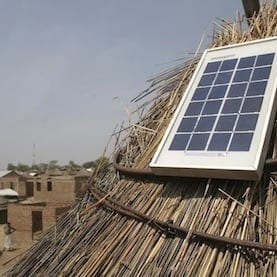
Electricity that is suitable for use in homes and small businesses
Solar power start-up GreenRay Inc. has developed the SunSine AC “solar appliance” that integrates the complex components of conventional solar power systems into modular, plug-and-play panels for easier installation, reduced cost, and increased safety. GreenRay designed the SunSine AC to produce standard alternating current (AC) electricity that is suitable for use in homes and small businesses, and the company hopes that by simplifying the technology and making it more affordable, it can make solar power more accessible to homeowners.
GreenRay calls its SunSine AC module the “world’s first solar appliance” because it integrates into a single package the separate components found in typical photovoltaic (PV) systems such as the PV panel, grid tie inverter, mounting hardware, and wiring. Each SunSine AC module contains a proprietary micro inverter that converts the sunlight the unit collects into AC electricity which is then fed into the electrical distribution panel supplying power to the home. According to GreenRay, any unused electricity is sent to the utility, which usually results in rebates to the home-owner.
GreenRay says the process of designing a system for the home is greatly simplified because each SunSine AC module is an independent building block. By simply combining multiple modules, a system can be tailored to each home-owner’s specific needs. In addition, the amount of labor required for installation is reduced because the SunSine AC modules plug together with quick-connect AC cables and snap into a specially-designed roof mount.
“The greatest barrier to mainstream solar adoption has been its complexity,” said GreenRay CEO Miles Russell. “For decades the market has been clamoring for a solar product that is easy to understand, simple to work with, and provides long-lasting dependable energy production. The SunSine AC Module brings solar to a new level of availability and quality.”
In traditional solar power systems, solar cells generate direct current (DC) electricity. To use this energy to power a household requires converting the electricity into alternating current (AC) – the same type of energy that comes in from the utility grid. The conversion is handled by an inverter, typically mounted in a home’s basement. Groups of PV modules must be installed and optimized to work with the central solar power inverter. These systems require careful planning because the specific number of PV panels that can be matched to a central inverter depends on climate, location, and other factors.
Unlike conventional PV systems, a GreenRay SunSine AC module combines all of the electrical components into a single package. A central inverter is not required because each module has its own micro inverter. GreenRay claims this arrangement is safer because installers are dealing with lower voltages.
Related articles by Zemanta
- Cambridge start-up hails solar panel breakthrough (businessgreen.com)
- GreenVolts Is All-In-One Solar Power Plant (earthtechling.com)
- How long on average do solar panels last on your house? (greenanswers.com)









